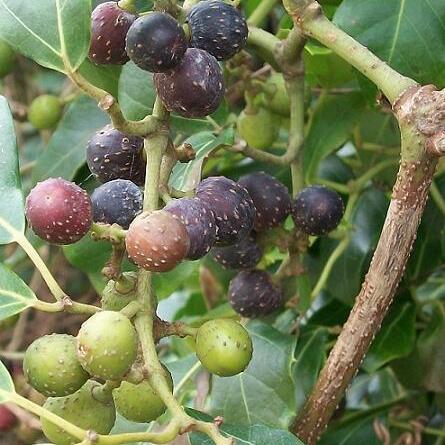Tall climber. Stems with young parts ferruginous-villous. Leaves petiolate; 3-foliolate; leaflets with petiolules, terminal leaflet rhomboid, up to 70 x 60 mm, base cuneate, apex acuminate, margins dentate in upper half of blade, each dentition with a distinct mucro, ± 1 mm long, lateral leaflets with asymmetrical bases; petioles up to 25 mm long. Flowers in leaf-opposed clusters. Petals green. Flowering time Sept.-Jan. Fruit ± globose, 10 mm in diam., dark red to purple.
Ramulis foliisque novellis fulvo-villosis, adultis fere glabris, foliis petiolatis subtus reticulatis, intermedio rhomboideo, basi cuneato, acuto supra medium paucidentato, dentibus parvis acutis, lateralibus oblique ovatis, acutis et paucidentatis, cymis paucifloris, pedunculis brevibus pilosis, cirrhis simplicibus.
Leaves 3-foliolate; petiole up to 2·3 cm. long; stipules not seen; leaflet-lamina up to 6 × 4 cm., terminal obovate, laterals asymmetric, rhomboid, apex acuminate, margins with c. 6 acuminate dentations, base cuneate; petiolules up to 1–4 cm. long.
Woody climber. Leaves 3-foliolate, leaflet lamina up to 60 x 40 mm, terminal leaflet obovate, lateral leaflets asymmetrically rhomboid, margins with dentations having an apiculus at least 1 mm long. Flowers green.
Inflorescences of moderately dense cymes, branches of inflorescence ± persistently ferruginous-villous; peduncle up to 1 cm. long; pedicels c. 2 mm. long; bracts c. 8 × 6 mm., rotund, ferruginous-villous.
Seeds 1–2, c. 8 × 7 mm., ellipsoid-globose, one side flattened when seeds in pairs; testa pale brown, slightly rugose, not furrowed.
Scrambling vine or tall liane; young parts ferruginous-villous with long weak hairs, soon glabrescent; tendrils glabrescent.
Fruit c. 1 cm. diam., subglobose, glabrous.
Flowers glabrous.

